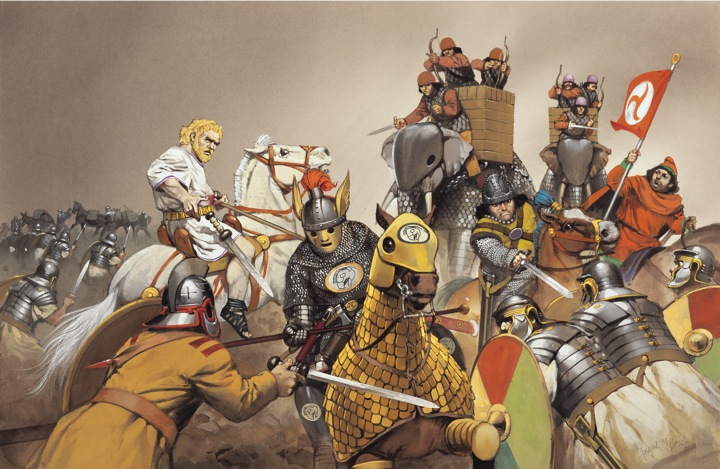Dr. Javier Sánchez Gracia has written the first ever book in Spanish on the conflicts between Rome and Persia:

Imperios de las Arenas: Roma y Persia Frente a Frente (Empires at the sand: Rome and Persia Face to Face). Readers can obtain a copy by visiting this link here …
Dr. Gracia has a degree in Classical Philology from the University of Zaragoza (Spain) and is a doctor of Sciences of Antiquity from the same university. He has participated in several congresses of Classical Philology in Spain and published scientific papers and articles. His research topics are the Roman historian Ammianus Marcellinus; the history of pre-Islamic Persia, and the image of Persia among classical Greco-Roman authors. In this endeavor, Dr. Gracia has also recently co-authored an article with Kaveh Farrokh in the Persian Heritage Journal entitled:

Dr. Javier Sánchez Gracia of the University of Zaragoza (seated) during the book signing of his recent text “Imperios de las Arenas: Roma y Persia Frente a Frente” (Empires at the sand: Rome and Persia Face to Face). The book signing above occurred during the “Feria del Libro de Zaragoza” book fair in Zaragoza, Spain on April 23, 2017. Standing next to Dr. Gracia is his friend and colleague Dr. Manuel Ferrando, also an accomplished historian from the University of Zaragoza, Spain.
Dr. Gracia’s book consists of the following chapters:
- The Seleucid Empire
- The Roman Republican Army
- The Parthian Empire
- Mithridates
- The Battle of Carrhae
- Marcus Antonius
- The Parthians: from Carrhae to the Sassanian uprising
- The Sassanian Empire: Rome vs Ctesiphon
Although Gracia’s textbook has a military focus, the rest of the subjects in his work also provide detailed analyses on the political and religious life of both empires. We are provided with exhaustive notes on the religion and the politics of the Parthians and Sassanians, even as the book focuses on an academic military analysis of the Romano-Persian conflicts, with particular attention paid to the structure of the armies of the ancient superpower rivals.
The book has done an excellent work in avoiding the pitfalls of (all too familiar) stereotyping and value judgements. This has resulted in Dr. Gracia’s objective analysis of each empire. Interestingly, Dr. Gracia also works to point out the contradictions, errors and falsehoods created by Greco-Roman authors. For this reason, Gracia has not just relied on classic scholarship (e.g. Polybius, Plutarchus, Tacitus, Ammianus…) but also on archaeology and modern historians.
Gracia’s central chapter is the battle of Carrhae, because it is a turning point for Roman expansionism and, with the defeat of Crassus, the political “propaganda” against Persia takes strength.

Parthian Horse archers engage the Roman legions of Marcus Lucinius Crassus at Carrhae in 53 BCE. Unlike the Achamenid-Greek wars where Achaemenid arrows were unable to penetrate Hellenic shields and armor, Parthian archery was now able to penetrate the armor and shields of their Roman opponents (Picture Source: Antony Karasulas & Angus McBride).
After examining the fall of the Parthians and the rise of the Sassanians, the book dedicates its last two chapters to Sassanian Persia. In one of these chapters, the history, politics and economy of Sassanian Persia, the primary “enemy” of Rome, is examined in academic detail. Gracia’s final chapter focuses on the struggles between the Romans and Sassanians, until the death of Julian “The apostate” in his failed invasion of Persia in 363 CE.

Emperor Julian is killed during his failed invasion of Sassanian Persia in June 26, 363 CE. Above is a recreation of Sassanian Persia’s elite cavalry, the Savaran, as they would have appeared during Julian’s failed invasion. Note the heavily armored Sassanian elite guardsman (Pushtighban) whose lance has pierced a Roman infantryman. Further right is a Savaran officer whose sword is drawn in what is now known as the “Italian grip” but Sassanian in origin. To the far right can be seen a Zoroastrian or Mithraist Magus brandishing a Sassanian era symbol. Also of interest are the armored elephants in the background. Armored elephants were especially prized as their cabs afforded very high elevation over the battlefield, which was ideal for Sassanian archery (Picture source: Farrokh, Plate D, Elite Sassanian cavalry, 2005).
In summary, Gracia’s book is the first Spanish language academic textbook on the military history of the Romans and Partho-Sassanians. As with a new generation of Western historians, Gracia avoids classical prejudices and clichés to arrive at a balanced and objective standard of scholarship. This sets a new approach in the study of the history of the ancient world beyond Rome: the realm of pre-Islamic Persia.




